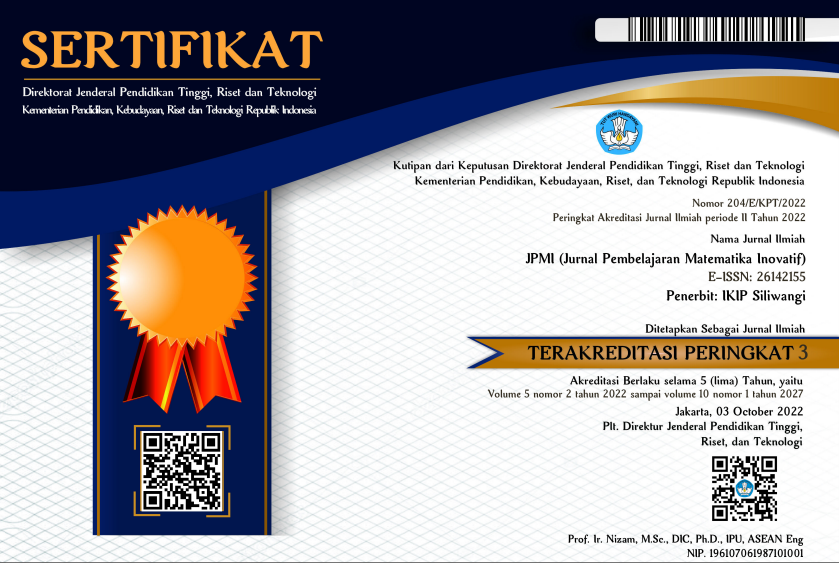ANALISIS KEMAMPUAN BERPIKIR KREATIF MATEMATIS SISWA DALAM MENYELESAIKAN SOAL OPEN-ENDED PADA MATERI SISTEM KOORDINAT KARTESIUS
DOI:
https://doi.org/10.22460/jpmi.v6i3.17579Keywords:
Creative Thinking Ability, cartesius coordinate system, Open-ended QuestionAbstract
References
Abidin, J., Rohaeti, E. E., & Afrilianto, M. (2018). Analisis kemampuan berpikir kreatif matematis siswa smp kelas viii pada materi bangun datar. JPMI (Jurnal Pembelajaran Matematika Inovatif), 1(4), 779–783. https://doi.org/10.22460/jpmi.v1i4.p779-784
Amelia, S. R., & Pujiastuti, H. (2020). Analisis kemampuan berpikir kreatif matematis melalui tugas open-ended. JPMI (Jurnal Pembelajaran Matematika Inovatif), 3(3), 247–258. https://doi.org/10.22460/jpmi.v3i3.247-258
Damayanti, H. T., & Sumardi, S. (2018). Mathematical creative thinking ability of junior high school students in solving open-ended problem. JRAMathEdu (Journal of Research and Advances in Mathematics Education), 3(1), 36–45. https://doi.org/10.23917/jramathedu.v3i1.5869
Faelasofi, R. (2017). Identifikasi kemampuan berpikir kreatif matematika pokok bahasan peluang. JURNAL E-DuMath, 3(2), 155–163. https://doi.org/10.26638/je.460.2064
Hidayat, P. W., & Widjajanti, D. B. (2018). Analisis kemampuan berpikir kreatif dan minat belajar siswa dalam mengerjakan soal open ended dengan pendekatan CTL. Pythagoras: Jurnal Pendidikan Matematika, 13(1), 63–75. https://doi.org/10.21831/pg.v13i1.21167
Lely, M., Putra, Z. H., & Syahrilfuddin, S. (2020). Fifth grade students’ creative thinking in solving open-ended mathematical problems. Journal of Teaching and Learning in Elementary Education (Jtlee), 3(1), 58–68. https://doi.org/10.33578/jtlee.v3i1.7829
Moma, L. (2015). Pengembangan instrumen berpikir kreatif matematis untuk siswa SMP. Delta-Pi:Jurnal Matematika Dan Pendidikan Matematika, 4(1), 27–41.
Mursidik, E. M., Samsiyah, N., & Rudyanto, H. E. (2015). Creative thinking ability in solving open-ended mathematical problems viewed from the level of mathematics ability of elementary school students. Pedagogia, 4(1), 23–33.
Noer, S. H. (2011). Kemampuan berfikir kreatif matematis pembelajaran matematika berbasis masalah open-ended. Jurnal Pendidikan Matematika, 5(1), 104–111.
Nurdiyani, O. (2020). Pengaruh penggunaan permainan terhadap minat dan hasil belajar siswa materi sistem koordinat kartesius pada siswa SMP. D3 thesis, Universitas Jambi.
Pratiwi, I., Amaliyah, A., & Rini, C. P. (2021). Analisis kemampuan berpikir kreatif matematis siswa dalam menyelesaikan soal cerita di kelas iv mi al-kamil kota tangerang. Berajah Journal, 2(1), 1–5. https://doi.org/10.47353/bj.v2i1.43
Rahayuningsih, S., Sirajuddin, S., & Ikram, M. (2021). Using open-ended problem-solving tests to identify students’ mathematical creative thinking ability. Participatory Educational Research, 8(3), 285–299. https://doi.org/10.17275/per.21.66.8.3
Rahmah, N. (2018). Hakikat pendidikan matematika. Al-Khwarizmi: Jurnal Pendidikan Matematika Dan Ilmu Pengetahuan Alam, 1(2), 1–10. https://doi.org/10.24256/jpmipa.v1i2.88
Ruhyana. (2016). Analisis kesulitan siswa dalam pemecahan masalah matematika. Jurnal Computech & Bisnis, 10(2), 106–118.
Safitri, A. N., & Rahaju, E. B. (2014). Identifikasi tingkat kemampuan berpikir kreatif siswa smp dalam menyelesaikan soal open ended pada materi segiempat. Jurnal Ilmiah Pendidikan Matematika, 3(3), 16–22.
Silver, E. A. (1997). Fostering creativity through instruction rich in mathematical problem solving and problem posing. Zentralblatt Für Didaktik Der Mathematik, 29(3), 75–80. https://doi.org/10.1007/s11858-997-0003-x
Singer, F. M., & Voica, C. (2015). Is Problem posing a tool for identifying and developing mathematical creativity? in mathematical problem posing: from research to effective practice. https://doi.org/10.1007/978-1-4614-6258-3
Sriraman, B. (2009). The characteristics of mathematical creativity. ZDM - International Journal on Mathematics Education, 41(1), 13–27. https://doi.org/10.1007/s11858-008-0114-z
Subekti, F. E., Rochmad, & Isnarto. (2021). Kemampuan representasi visual siswa dalam memecahkan masalah sistem koordinat kartesius. Prisma Prosiding Seminar Nasional Matematika, 4, 217–222. https://journal.unnes.ac.id/sju/index.php/prisma/article/view/44966
Wanelly, W., & Fauzan, A. (2020). Pengaruh pendekatan open ended dan gaya belajar siswa terhadap kemampuan berpikir kreatif matematis. Jurnal Basicedu, 4(3), 523–533. https://doi.org/10.31004/basicedu.v4i3.388.

















